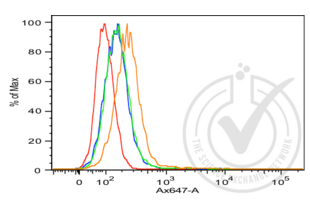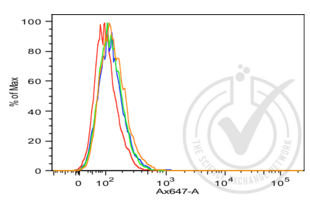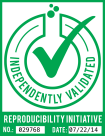E-cadherin antibody (AA 401-500)
-
- Target See all E-cadherin (CDH1) Antibodies
- E-cadherin (CDH1) (Cadherin 1, Type 1, E-Cadherin (Epithelial) (CDH1))
-
Binding Specificity
- AA 401-500
-
Reactivity
- Human, Mouse, Rat
-
Host
- Rabbit
-
Clonality
- Polyclonal
-
Conjugate
- This E-cadherin antibody is un-conjugated
-
Application
- Western Blotting (WB), Flow Cytometry (FACS), ELISA, Immunohistochemistry (Paraffin-embedded Sections) (IHC (p)), Immunocytochemistry (ICC), Immunofluorescence (Paraffin-embedded Sections) (IF (p)), Immunohistochemistry (Frozen Sections) (IHC (fro)), Immunofluorescence (Cultured Cells) (IF (cc))
- Cross-Reactivity
- Human, Mouse, Rat
- Predicted Reactivity
- Cow,Pig,Horse,Rabbit
- Purification
- Purified by Protein A.
- Immunogen
- KLH conjugated synthetic peptide derived from human E-cadherin
- Isotype
- IgG
-
-
- Application Notes
-
WB 1:300-5000
ELISA 1:500-1000
FCM 1:20-100
IHC-P 1:200-400
IHC-F 1:100-500
IF(IHC-P) 1:50-200
IF(IHC-F) 1:50-200
IF(ICC) 1:50-200
ICC 1:100-500 - Restrictions
- For Research Use only
-
- by
- Flow Cytometry & Cell Separation Facility, Purdue University
- No.
- #029768
- Date
- 07/22/2014
- Antigen
- Lot Number
- 130902
- Method validated
- Flow Cytometry
- Positive Control
- MCF-7 cells
- Negative Control
- SH-SY5Y cells
- Notes
- A weak but specific signal is observed in the positive control MCF7 cells stained with anti-E-Cadherin plus secondary antibody compared with isotype, secondary only and unstained cells. No staining was observed in the negative control SH-SY5Y cells as expected.
- Primary Antibody
- Antigen: Cadherin 1, Type 1, E-Cadherin (Epithelial) (CDH1)
- Catalog number: ABIN1387847
- Lot number: 130902
- Dilution: 1 µg in 100 µL 1X PBS containing 0.5% BSA
- Secondary Antibody
- Antibody: Goat anti-rabbit IgG-Alexa 647
- Dilution: 1:500 in 1X PBS containing 0.5% BSA
- Full Protocol
- Positive and negative control cells were cultured in DMEM + 10% FBS. - Positive and negative control cells were washed once with phosphate-buffered saline (PBS) and harvested with a non-enzymatic cell dissociation solution (Cellstripper, Mediatech, Inc).
- Detached cells were washed twice and resuspended in 100 µL 1X PBS containing 0.5% BSA: - unstained cells - secondary antibody alone - isotype control antibody + secondary antibody - primary antibody + secondary antibody
- Cells were incubated for 30 min on ice.
- Labeled cells were washed twice in PBS containing 0.5% BSA.
- Cells were resuspended with 1X PBS containing 0.5% BSA + 10% goat serum and incubated for 15 min at room temperature.
- Goat anti-rabbit IgG-Alexa 647 secondary antibody (Jackson Immunoresearch) was added at a 1:500 dilution. The cells were incubated for 30 min in the dark on ice.
- Labeled cells were washed twice in PBS containing 0.5% BSA.
- Propidium Iodide (PI) was added to discern live cells from dead cells.
- Cells were analyzed on a FACSAria III (BD Biosciences) using a red laser (640 nm excitation / 660 nm emission).
- Experimental Notes
- - The data displayed is gated on PI negative cells.
Validation #029768 (Flow Cytometry)![Successfully validated 'Independent Validation' Badge]()
![Successfully validated 'Independent Validation' Badge]() Validation Images
Validation Images![Figure 1: Positive control MCF7 cells. The red histogram is unstained cells, the blue histogram is cells stained with secondary antibody alone, the green histogram is cells stained with rabbit IgG isotype control antibody plus secondary antibody and the orange histogram is cells stained with anti-E-Cadherin plus secondary antibody. The secondary antibody is a goat anti-rabbit IgG-Alexa 647 (Jackson Immunoresearch).]() Figure 1: Positive control MCF7 cells. The red histogram is unstained cells, the blue histogram is cells stained with secondary antibody alone, the green histogram is cells stained with rabbit IgG isotype control antibody plus secondary antibody and the orange histogram is cells stained with anti-E-Cadherin plus secondary antibody. The secondary antibody is a goat anti-rabbit IgG-Alexa 647 (Jackson Immunoresearch).
Figure 1: Positive control MCF7 cells. The red histogram is unstained cells, the blue histogram is cells stained with secondary antibody alone, the green histogram is cells stained with rabbit IgG isotype control antibody plus secondary antibody and the orange histogram is cells stained with anti-E-Cadherin plus secondary antibody. The secondary antibody is a goat anti-rabbit IgG-Alexa 647 (Jackson Immunoresearch).
![Figure 2: Negative control SH-SY5Y cells. The red histogram is unstained cells, the blue histogram is cells stained with secondary antibody alone, the green histogram is cells stained with rabbit IgG isotype control antibody plus secondary antibody and the orange histogram is cells stained with anti-E-Cadherin plus secondary antibody. The secondary antibody is a goat anti-rabbit IgG-Alexa 647 (Jackson Immunoresearch).]() Figure 2: Negative control SH-SY5Y cells. The red histogram is unstained cells, the blue histogram is cells stained with secondary antibody alone, the green histogram is cells stained with rabbit IgG isotype control antibody plus secondary antibody and the orange histogram is cells stained with anti-E-Cadherin plus secondary antibody. The secondary antibody is a goat anti-rabbit IgG-Alexa 647 (Jackson Immunoresearch).
Full Methods
Figure 2: Negative control SH-SY5Y cells. The red histogram is unstained cells, the blue histogram is cells stained with secondary antibody alone, the green histogram is cells stained with rabbit IgG isotype control antibody plus secondary antibody and the orange histogram is cells stained with anti-E-Cadherin plus secondary antibody. The secondary antibody is a goat anti-rabbit IgG-Alexa 647 (Jackson Immunoresearch).
Full Methods -
- Format
- Liquid
- Concentration
- 1 μg/μL
- Buffer
- 0.01M TBS( pH 7.4) with 1 % BSA, 0.02 % Proclin300 and 50 % Glycerol.
- Preservative
- ProClin
- Precaution of Use
- This product contains ProClin: a POISONOUS AND HAZARDOUS SUBSTANCE, which should be handled by trained staff only.
- Storage
- 4 °C,-20 °C
- Storage Comment
- Shipped at 4°C. Store at -20°C for one year. Avoid repeated freeze/thaw cycles.
- Expiry Date
- 12 months
-
-
: "miR-375-3p/YWHAZ/β-catenin axis regulates migration, invasion, EMT in gastric cancer cells." in: Clinical and experimental pharmacology & physiology, Vol. 46, Issue 2, pp. 144-152, (2019) (PubMed).
: "Sulfate Aerosols Promote Lung Cancer Metastasis by Epigenetically Regulating the Epithelial-to-Mesenchymal Transition (EMT)." in: Environmental science & technology, Vol. 51, Issue 19, pp. 11401-11411, (2018) (PubMed).
: "Upregulation of long noncoding RNA CCAT1-L promotes epithelial-mesenchymal transition in gastric adenocarcinoma." in: OncoTargets and therapy, Vol. 11, pp. 5647-5655, (2018) (PubMed).
: "TFF3 Contributes to Epithelial-Mesenchymal Transition (EMT) in Papillary Thyroid Carcinoma Cells via the MAPK/ERK Signaling Pathway." in: Journal of Cancer, Vol. 9, Issue 23, pp. 4430-4439, (2018) (PubMed).
: "Phosphorylation-dependent regulation of ALDH1A1 by Aurora kinase A: insights on their synergistic relationship in pancreatic cancer." in: BMC biology, Vol. 15, Issue 1, pp. 10, (2017) (PubMed).
: "HET0016 decreases lung metastasis from breast cancer in immune-competent mouse model." in: PLoS ONE, Vol. 12, Issue 6, pp. e0178830, (2017) (PubMed).
: "Notch1 signaling induces epithelial-mesenchymal transition in lens epithelium cells during hypoxia." in: BMC ophthalmology, Vol. 17, Issue 1, pp. 135, (2017) (PubMed).
: "The Aurora-A-Twist1 axis promotes highly aggressive phenotypes in pancreatic carcinoma." in: Journal of cell science, Vol. 130, Issue 6, pp. 1078-1093, (2017) (PubMed).
: "Influenza virus damages the alveolar barrier by disrupting epithelial cell tight junctions." in: The European respiratory journal, Vol. 47, Issue 3, pp. 954-66, (2016) (PubMed).
: "Hydroxysafflor Yellow A Ameliorates Renal Fibrosis by Suppressing TGF-β1-Induced Epithelial-to-Mesenchymal Transition." in: PLoS ONE, Vol. 11, Issue 4, pp. e0153409, (2016) (PubMed).
: "Lenticular cytoprotection, part 2: link between glycogen synthase kinase-3?, epithelial to mesenchymal transition, and mitochondrial depolarization." in: Molecular vision, Vol. 20, pp. 1758-75, (2015) (PubMed).
: "Extracellular vesicles in urine of women with but not without kidney stones manifest patterns similar to men: a case control study." in: Biology of sex differences, Vol. 6, pp. 2, (2015) (PubMed).
: "MicroRNA-328 inhibits renal tubular cell epithelial-to-mesenchymal transition by targeting the CD44 in pressure-induced renal fibrosis." in: PLoS ONE, Vol. 9, Issue 6, pp. e99802, (2014) (PubMed).
: "Roles of transcriptional factor Snail and adhesion factor E-cadherin in clear cell renal cell carcinoma." in: Experimental and therapeutic medicine, Vol. 6, Issue 6, pp. 1489-1493, (2013) (PubMed).
-
: "miR-375-3p/YWHAZ/β-catenin axis regulates migration, invasion, EMT in gastric cancer cells." in: Clinical and experimental pharmacology & physiology, Vol. 46, Issue 2, pp. 144-152, (2019) (PubMed).
-
- Target
- E-cadherin (CDH1) (Cadherin 1, Type 1, E-Cadherin (Epithelial) (CDH1))
- Alternative Name
- E cadherin (CDH1 Products)
- Background
-
Synonyms: UVO, CDHE, ECAD, LCAM, Arc-1, CD324, Cadherin-1, CAM 12/8, Epithelial cadherin, E-cadherin, Uvomorulin, CDH1
Background: Cadherins are calcium-dependent cell adhesion proteins. They preferentially interact with themselves in a homophilic manner in connecting cells, cadherins may thus contribute to the sorting of heterogeneous cell types. CDH1 is involved in mechanisms regulating cell-cell adhesions, mobility and proliferation of epithelial cells. Has a potent invasive suppressor role. It is a ligand for integrin alpha-E/beta-7. E-Cad/CTF2 promotes non-amyloidogenic degradation of Abeta precursors. Has a strong inhibitory effect on APP C99 and C83 production.
- Gene ID
- 999
- UniProt
- P12830
- Pathways
- WNT Signaling, Sensory Perception of Sound, Cell-Cell Junction Organization, Tube Formation
-



 (14 references)
(14 references) (1 validation)
(1 validation)



